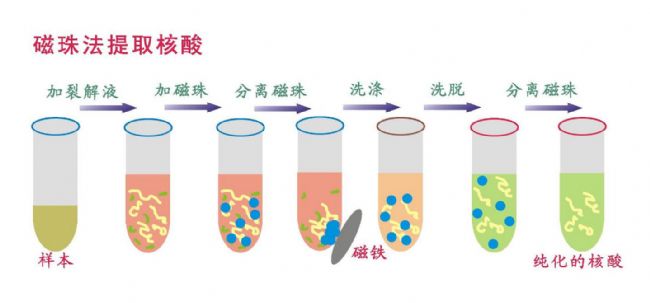How to choose a biomagnetic bead?
Article source: Luoyang Jiente Biotechnology Co., Ltd. As a new effective carrier for extracting nucleic acids, biomagnetic beads (or biological microspheres) have been rapidly promoted in China and recognized by the majority of scientific research workers. The industry is referred to as the “Magnetic Bead Methodâ€, which is easy to operate and combined with automated instruments. The combination has significantly improved work efficiency and has gradually become a mainstream solution. However, the quality of the magnetic beads is not good enough, the extraction effect is not satisfactory, it is really a big headache, and even doubt the feasibility of this new extraction scheme. So how do we buy a biomagnetic bead? Combine the steps, you can analyze it from the following perspectives: 1 , settling speed The sedimentation velocity is often an important indicator. The slower the sedimentation velocity, the better the uniformity of the sample loading and the better the operating experience. However, considering the comprehensive performance of the magnetic beads, the sedimentation velocity is generally controlled at 10-20 min, and some of the magnetic beads are sinking fast. The sedimentation speed is only 3-5min, which requires attention to the mixing frequency of the magnetic beads in the actual operation, so as to avoid unevenness of the sample loading, resulting in unstable results. 2 , magnetic time The short magnetic attraction time indicates that the magnetic beads have strong magnetic responsiveness, which is more convenient in the actual operation process, but the shorter the magnetic induction time, the faster the sedimentation speed. Overall, the magnetization time is within the acceptable range of 30s. However, some brands of magnetic beads include imported magnetic beads, the magnetic extraction time is more than 1min, which will significantly increase the waiting time during operation, reducing operating efficiency. 3 , nucleic acid adsorption capacity Many customers believe that the magnetic adsorption capacity of magnetic beads is related to the particle size of magnetic beads. Magnetic beads with small particle size have large specific surface area, so the adsorption capacity is strong. This conclusion is theoretically true, but in practice, when the magnetic beads are used for nucleic acid adsorption, 5-6 kinds of reagents need to be matched, so the magnetic beads are required to adsorb more nucleic acids, the entire reagent system and the magnetic beads and The compatibility of reagents is an important factor affecting the extraction results. Magnetic beads with small particle size are not suitable for any unoptimized reagent system. Therefore, instead of consuming energy to find magnetic beads with smaller particle size, it is better to optimize the whole reagent system and the efficiency may be higher. In addition, many manufacturers are not standard magnetic bead producers, which fundamentally cannot guarantee the use of finished magnetic beads. Imagine being a magnetic bead manufacturer, but unable to control the quality of important raw materials, which will directly lead to magnetic beads. The quality is unstable and the batch is unstable. The most intuitive performance on the product is the different batches of magnetic beads. The difference in sedimentation speed is large, the difference in magnetic attraction time is large, and the difference in adsorption capacity is large, which directly affects the extraction quality and efficiency. . Therefore, whether it is a research user or an industrial user, choosing a standard magnetic bead manufacturer is the key to ensuring the stability of the project. As a domestic standard magnetic bead manufacturer, Geent's GNT series of magnetic beads have been verified by customers in various industries. Even with different production batch numbers, there are no differences in parameters such as sedimentation speed, magnetic attraction speed and nucleic acid adsorption efficiency. Biomagnetic beads are a cross product of synthetic chemistry and molecular biology. Their applications focus on the field of molecular biology. From this perspective, biological companies will solve more practical problems. Therefore, for the user, the biological company will be connected to the magnetic bead products, and the efficiency in the after-sales service will be higher. It is recommended that the teachers look for the standard and biological types in the process of purchasing the magnetic beads in the future. Magnetic bead producer.
Tof(Time-of-flight), is JRT new product, which is a single-point LiDAR sensor. With a micro size of 46x17x7mm, customers can widely use in many Laser Measurement Solutions. The lidar distance sensor can measure 12m short-range. It's great for Unmanned Aerial Systems.Contact Us Now for data sheet.
ToF Sensor,Time of Flight Sensor,LiDAR Distance Sensor,ToF Distance Sensor Chengdu JRT Meter Technology Co., Ltd , https://www.infrareddistancesensor.com
Product Name
Tof LiDAR Sensor
Model Number
IT02S-65-A/IT02S-65-B/IT03M-650
Measuring Range (without Reflection)
0.1-12m/0.1-10m/0.1-15m(90% reflectivity)
Place of Origin
China
Accuracy
2cm~4cm/5cm
Blind Area
10cm
Resolution
1cm
Measuring Unit
centimetre
Laser Class
Class II, red
Laser Type
650nm, <1mW
Communication Interface
UART, 115200bps(default)
Size
46*17*7mm/50*26*13mm
Weight
About 4g/10g
Voltage
2.7V~+3.6V
Electrical Level
TTL/CMOS
High Frequency
100hz
Operating Temperature
0-40 ℃ (32-104 ℉ )
Storage Temperature
-25~60 ℃ (-13~140 ℉)